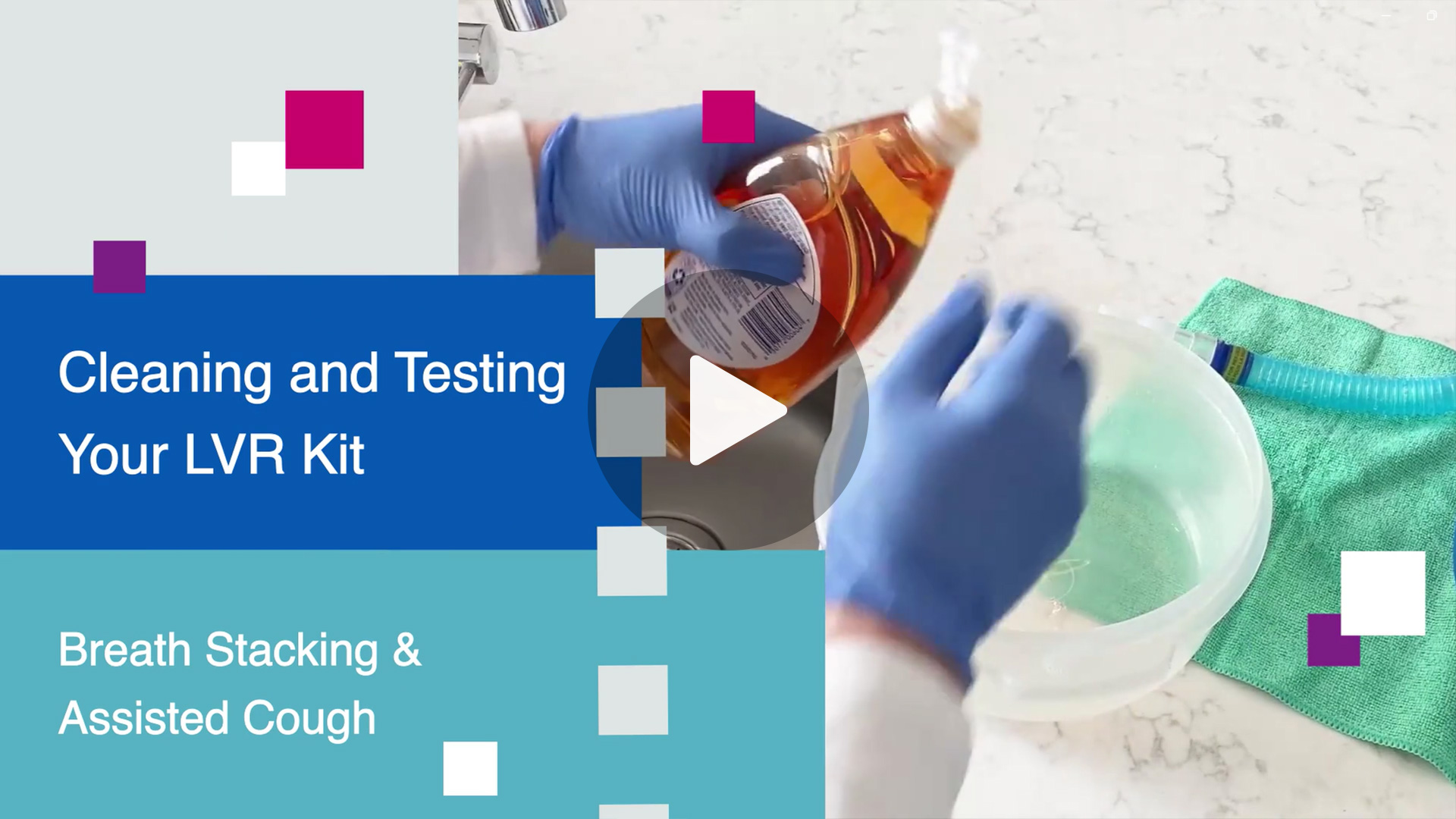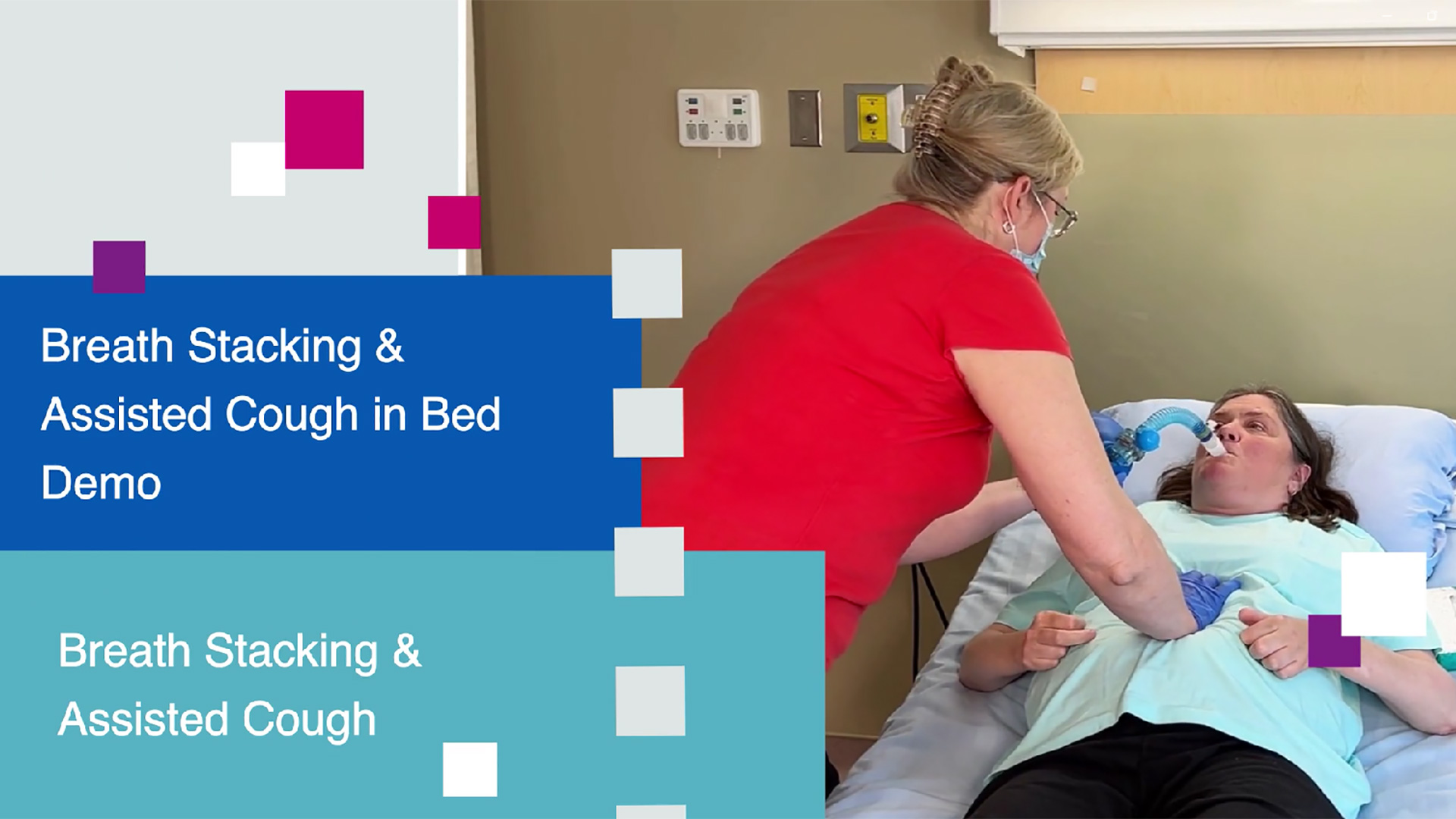An Assisted Cough uses a stomach thrust to help build pressure to produce a cough. This video demonstrates how to do the Assisted Cough technique while seated in a wheelchair. Sandra demonstrates and Renata assists with the stomach thrust with one hand and squeezing the LVR bag with the other hand.
If you are able to squeeze the bag yourself, you can do the bagging while the person assisting positions themselves for the stomach thrust.
Sandra places her wheelchair against a wall with the wheels locked so the pushing pressure doesn’t cause a tip. She has a pillow behind her head to avoid hitting the wall.
Here is the process Sandra and Renata demonstrate:
- the assistant places the palm of her hand below the ribcage and above the belly button
- they establish a signal for when her lungs are full – a wave, but you could also use a nod or blink
- Sandra takes a large breath in through the mouthpiece and holds her air
- the assistant squeezes and Sandra inhales successive breaths of bagged air, 2-5 times
- the assistant counts and says “breathe in” each time
- the assistant squeezes the bag with one hand until the lungs feel full and Sandra signals she cannot hold any more air
- once the lungs are full, and just before removing the mouthpiece from the mouth, the stomach thrust is started
- the assistant then pushes up – with some solid force – but not enough to injure the person
- Sandra coughs as the mouthpiece is removed.
If the Breath Stacking and Assisted Cough is successful, a high flow of exhaled air will occur as the mouthpiece is removed. If mucus is loosened, you might hear a rattling sound or feel congested. Cough out as much mucous as you can and spit it out into a container or tissue. Repeat the whole process 3 to 5 times or until all the mucous is out. Rest in between cycles. Clean the mouthpiece after use.
After Breath Stacking and Assisted Cough you should do two breath holds. The breath hold is done by giving you successive breaths using Breath Stacking. Instead of coughing at the end, hold your breath for as long as possible (3-5 seconds) before exhaling.
You know you’re doing it right when you have these signs:
- The chest rises with each squeeze
- There is no air leaking out around the nose or mouthpiece
- It is getting harder to squeeze the bag with each squeeze.
Not everybody needs the combined Breath Stacking and Assisted Cough all the time. If you have a cold, that’s when you would add an assisted cough as often as every 10 minutes.
If you think the Breath Stacking and Assisted Cough techniques are something you could benefit from, connect with your healthcare team to discuss lung volume testing and how to get the tools and assistance you’ll need to get started.
Remember: These LVR kits are not intended for use as resuscitation bag.
Do NOT do Breath Stacking if you feel light-headed, you have chest discomfort, an upset stomach or you have low blood pressure.
Additional notes for healthcare providers:
Use of the LVR kit is not recommended in the presence of hemoptysis, recent or current barotrauma, bullous emphysema, severe obstructive pulmonary diseases, hypotension.
- Do NOT use the LVR kit if the individual has an inflated tracheostomy cuff or endotracheal tube.
- Individual assessment and precaution should be taken if any of the following exists: severe reflux, IVC filter, Kyphoscoliosis, or Baclofen Pump.
- An Assisted Cough should not be done for any individuals that are pregnant or that have had recent abdominal surgery or have an abdominal aneurysm.
We hope you enjoy this video series and watching these demonstrations. If you have any questions about what you learn, be sure to reach out to your healthcare team or service and resource providers like Spinal Cord Injury Ontario.
We would like to acknowledge and thank the people with lived experience who contributed their insights and tips to the development of this video series:
- Ron Rattie, Peer Support Program Coordinator, Spinal Cord Injury Ontario
- Sandra Burton
- Matt Sagan, Peer Support Volunteer, Spinal Cord Injury Ontario
We would also like to thank Hamilton Health Sciences staff who provided clinical subject matter expertise, source content and expert review of this video series:
- Renata Vaughan, RRT Senior Registered Respiratory Therapist, Hamilton Health Sciences Regional Rehabilitation Centre
- Jennifer Duley, APP Advanced Practice Physiotherapist, Acute Spine Unit, Hamilton Health Sciences.
This series was designed by Marty Doupe, Learning Architect at SCIO.
The Lung Volume Recruitment (LVR) bag and the attachments are available for purchase as a preassembled kit. Here are two vendor options in Canada: – Medigas carries the Mercury Medical Lung Volume Recruitment Kit, product number is TRSM161034502 and price is approximately $60 CAD, https://www.medigas.com/en – ProResp sells the Mercury Medical LVR kit by the box of 6, https://www.proresp.com/




